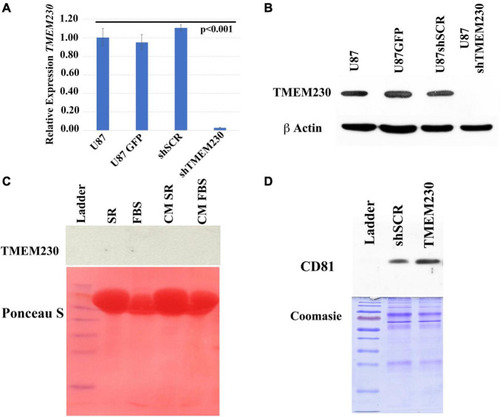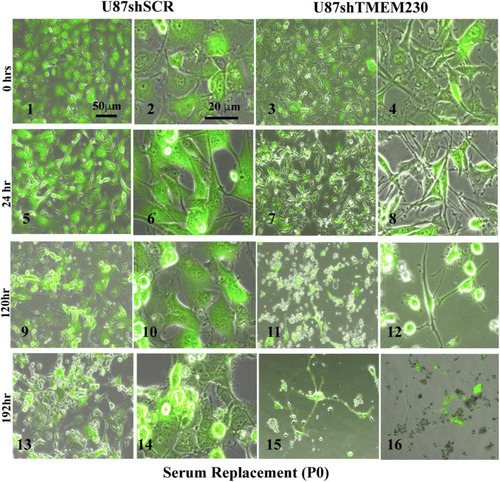- Title
-
Transmembrane Protein TMEM230, a Target of Glioblastoma Therapy
- Authors
- Cocola, C., Magnaghi, V., Abeni, E., Pelucchi, P., Martino, V., Vilardo, L., Piscitelli, E., Consiglio, A., Grillo, G., Mosca, E., Gualtierotti, R., Mazzaccaro, D., La Sala, G., Di Pietro, C., Palizban, M., Liuni, S., DePedro, G., Morara, S., Nano, G., Kehler, J., Greve, B., Noghero, A., Marazziti, D., Bussolino, F., Bellipanni, G., D'Agnano, I., Götte, M., Zucchi, I., Reinbold, R.
- Source
- Full text @ Front. Cell. Neurosci.
|
Expression of TMEM230 in brain Glioblastoma Multiforme (GBM) and Low-Grade Gliomas (LGG) analyzed from The Cancer Genome Atlas. (A) Glioblastoma multiforme tumors showed significantly elevated level of TMEM230 mRNA compared to low-grade gliomas (unpaired t-test p < 0.0001). Low-grade gliomas consist of astrocytoma, oligoastrocytoma and oligodendroglioma patient samples. (B) Poor prognosis was correlated with high TMEM230 in low-grade gliomas. (C) Poor prognosis was correlated with high TMEM230 in astrocytoma (top), oligoastrocytoma (middle) and oligodendroglioma (bottom). Relationship between TMEM230 expression levels and prognosis of low-grade gliomas affected patients indicated that lower expression of TMEM230 was associated with increased overall survival. Each glioma subtype is indicated by the median of gene expression of TMEM230. B and C analyses were generated from the Kaplan-Meier test based on the expression of medium TMEM230. (D) Representative heatmap displaying the most variable expressed genes for astrocytoma using the R with “pheatmap” package for which functional enrichment was generated with DAVID program. |
|
Validation of endogenous and lentivirus downregulation of TMEM230 mRNA and protein expression in U87-MG cells. (A) Validation of constitutive downregulation of endogenous TMEM230 transcript expression with lentiviral system. Endogenous control: HPRT, Error bars represent 95% confidence interval. (B) Validation of constitutive downregulation of endogenous TMEM230 protein expression with the lentiviral system. Endogenous control: β-actin. (C) Western blot analysis (top panel) showed TMEM230 protein was not detected in fetal bovine serum (FBS), serum replacement (SR) or conditioned media (CM) containing serum replacement or FBS (CM SR and CM FBS) obtained from endogenous TMEM230 expressing U87 cells. Ponceau S staining (lower panel) showed an abundance of protein was loaded. (D) Coomassie blue staining showed an increase of expression of extracellular vesicle membrane protein, CD81 in conditioned media of U87 cells constitutively over-expressing TMEM230 with respect to conditioned media collected from control cells (U87GFP and U87shSCR). Detection of CD81 (D) but lack of detection of TMEM230 protein in culture media (C) supports that the TMEM230 protein regulates extracellular vesicle generation or secretion but is not itself a component of extracellular vesicles. |
|
Downregulation of TMEM230 was sufficient to promote loss of U87-MG substratum adhesion capacity in fetal bovine serum containing media. Control (U87shSCR) and U87 cells in which TMEM230 was constitutively downregulated (U87shTMEM230) were cultured in extracellular vesicle depleted FBS (Fetal Bovine Serum) containing culture media. Equal number of control cells and cells in which endogenous TMEM230 was downregulated were plated (P0) in vesicle depleted FBS containing culture media and monitored over 72 h, starting from when green fluorescent protein (GFP) expression was first observed (0 h, not shown). Cells in which TMEM230 were downregulated displayed decrease in cytoplasm dimensions and disrupted cytoplasmic invadopodium like extensions. Cells were re-passaged (P1) and monitored for additional 144 h. Re-passaged cells (P1) displayed a more limited capacity for cell adhesion, supporting that TMEM230 is necessary for scaffold attachment of cells. |
|
Downregulation of endogenous TMEM230 was sufficient to promote loss of U87-MG substratum adhesion capacity in serum replacement containing media. Control (U87shSCR) and U87 cells in which TMEM230 was constitutively downregulated (U87shTMEM230) were cultured in serum replacement (SR) containing media (P0). Equal number of control cells and cells in which TMEM230 was downregulated were plated in SR containing culture media and monitored over 192 h, starting from when GFP expression was first observed (0 h). |
|
Human umbilical vein endothelial cells cultured in FBS and serum replacement containing conditioned media from U87-MG cells expressing endogenous TMEM230 promoted angiogenic behavior. (1–4) Representative images at 24 h of human umbilical vein endothelial cells (HUVEC) in Matrigel treated with conditioned media obtained from 3 days cultures of U87 control (U87shSCR) and U87 in which TMEM230 was down regulated (U87shTMEM230). (5–15) Human umbilical vein endothelial cells in 3D treated with conditioned media obtained from 3 days cultures of U87 control and U87 which TMEM230 was down regulated shown for without (5–9) and with angiogenic factors (11–14). U87 cells were cultured in media containing fetal bovine serum (FBS) or serum replacement (SR). |
|
Endogenous TMEM230 promoted U87-MG cell migration, tumor-endothelial cell contact and displacement in co-culture assays. (A) Low magnification shows the co-culture assay set up. (B) Representative images showing the periphery (outgrowth) and core (initial location of cell plating) of U87shTMEM230 cells at 48 h. Downregulation of TMEM230 in U87 cells was associated with cytoplasm of reduced mass, disrupted cytoplasmic invadopodium like extensions, decreased cell anchorage and reduced contacts among initially confluent plated cells. (C) Representative images of U87shTMEM230 cells at periphery and core at 9 days. U87 cells with reduced TMEM230 expression displayed reduced anchorage capacity and motility (see red circle at periphery of initial site of plating of the confluent cells) compared to control cells. (D–F) Displacement of the confluent human umbilical vein endothelial cells by U87 control cells (U87shSCR) expressing endogenous TMEM230 through infiltration into the confluent mass of human umbilical vein endothelial cells (see red circles), a behavior that is associated with the first step of intussusceptive induced blood vessel branching. |
|
Endogenous expression of TMEM230 promoted U87-MG migration and tubule like structure formation recapitulating a vascular mimicry like behavior. |
|
All enriched pathways identified with high or low TMEM230 expression in diverse patient glioma tumors. (A) Enriched pathways identified common between high or low TMEM230 expression in all LGG of patient. (B) Scheme for identifying different pathways between high or low TMEM230 expression in LGG and glioblastomas. (C) Enriched pathways identified different between high or low TMEM230 expression in LGG and glioblastoma. See corresponding Supplementary Table 12. |








